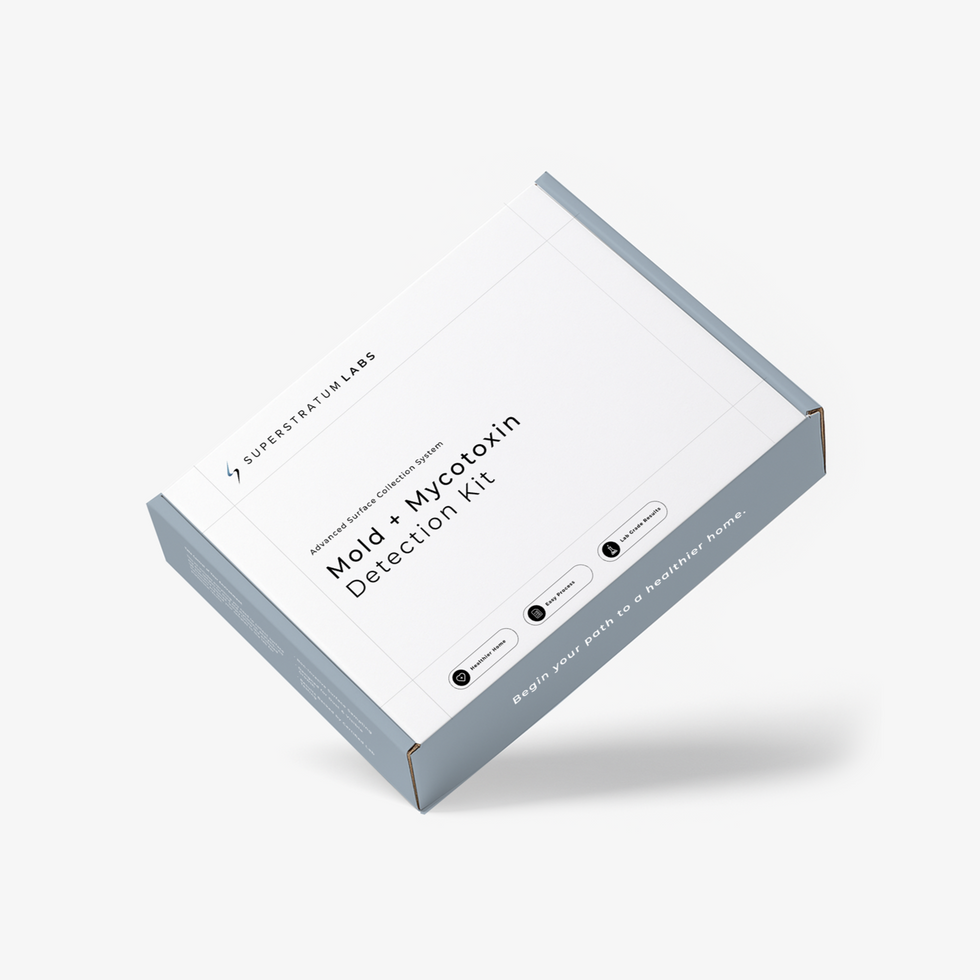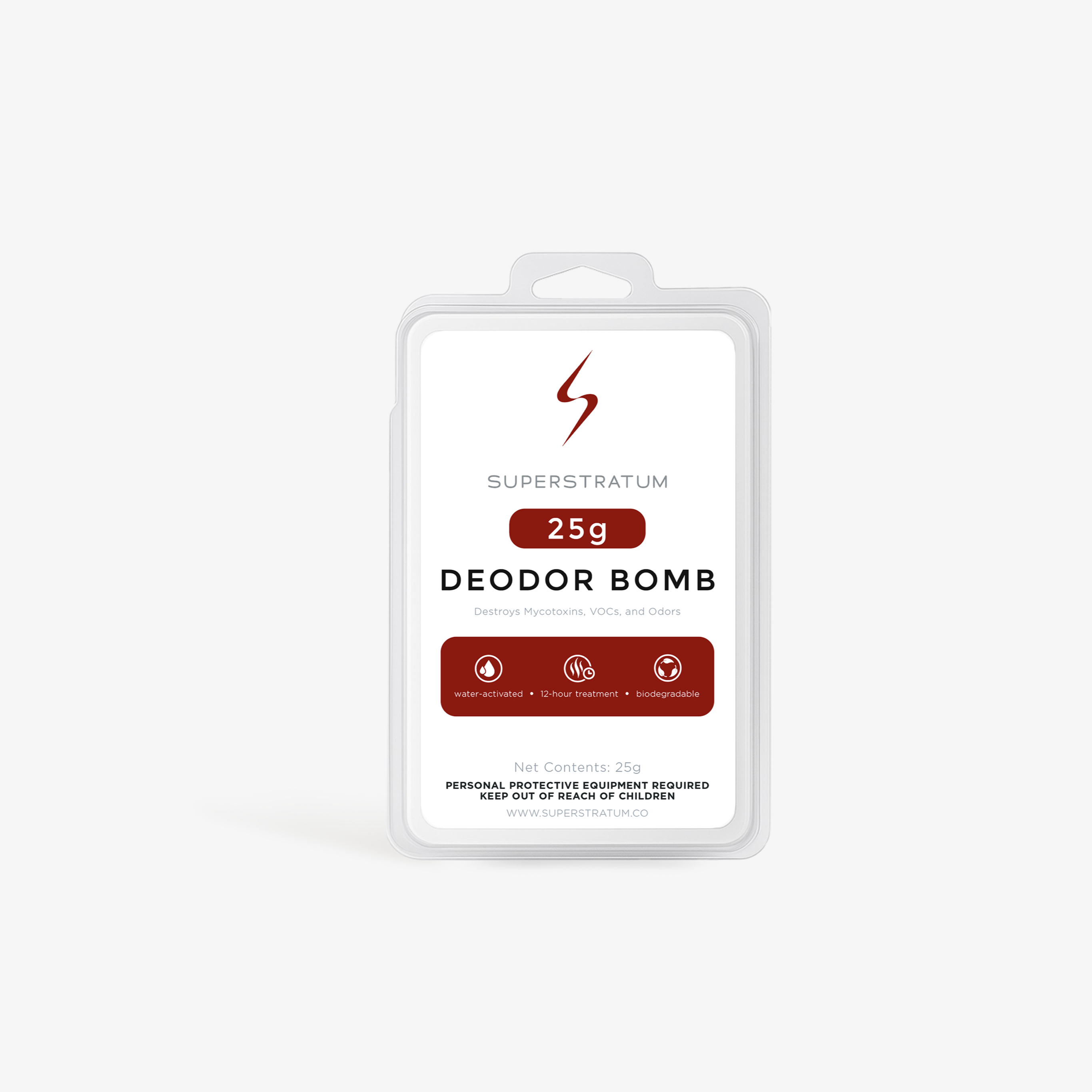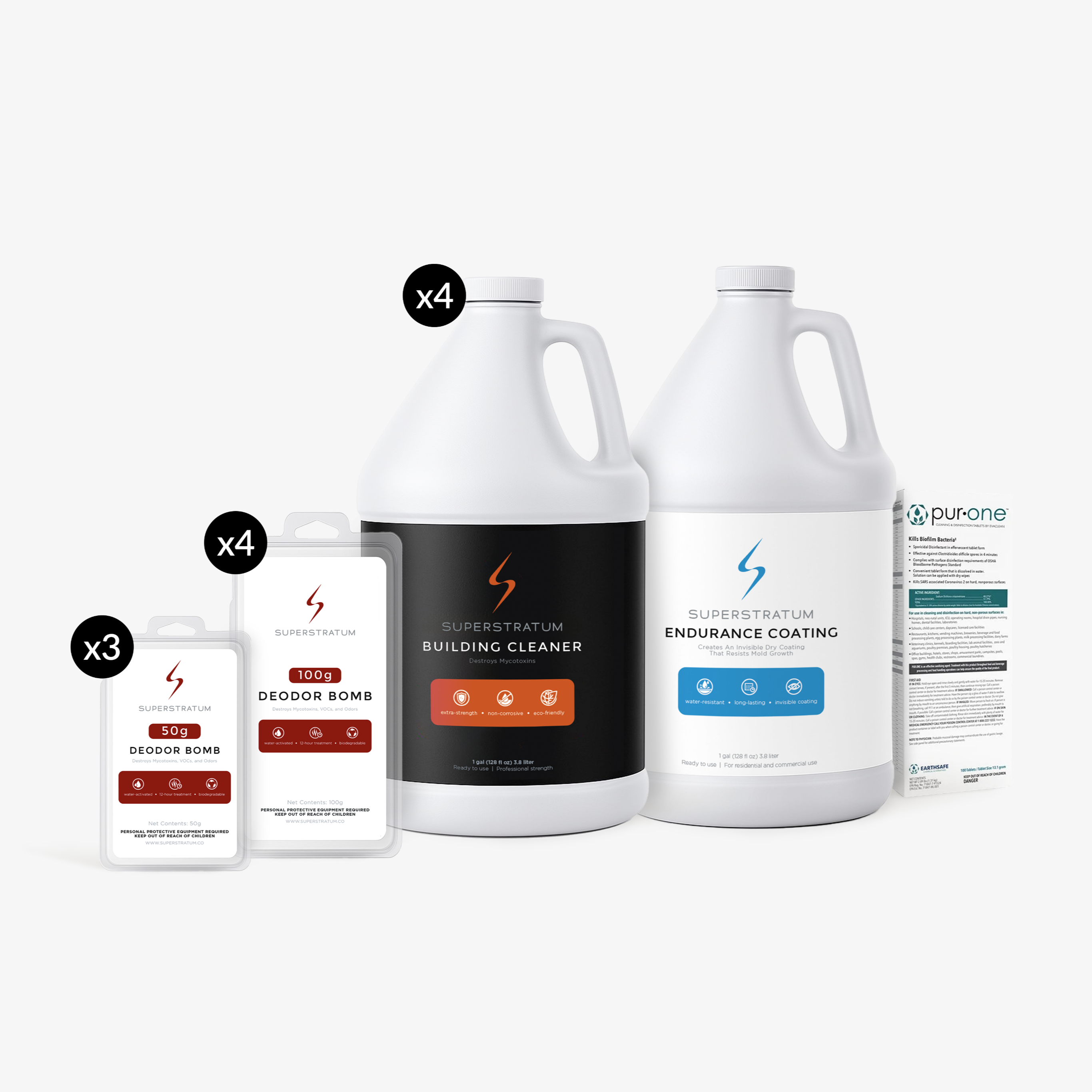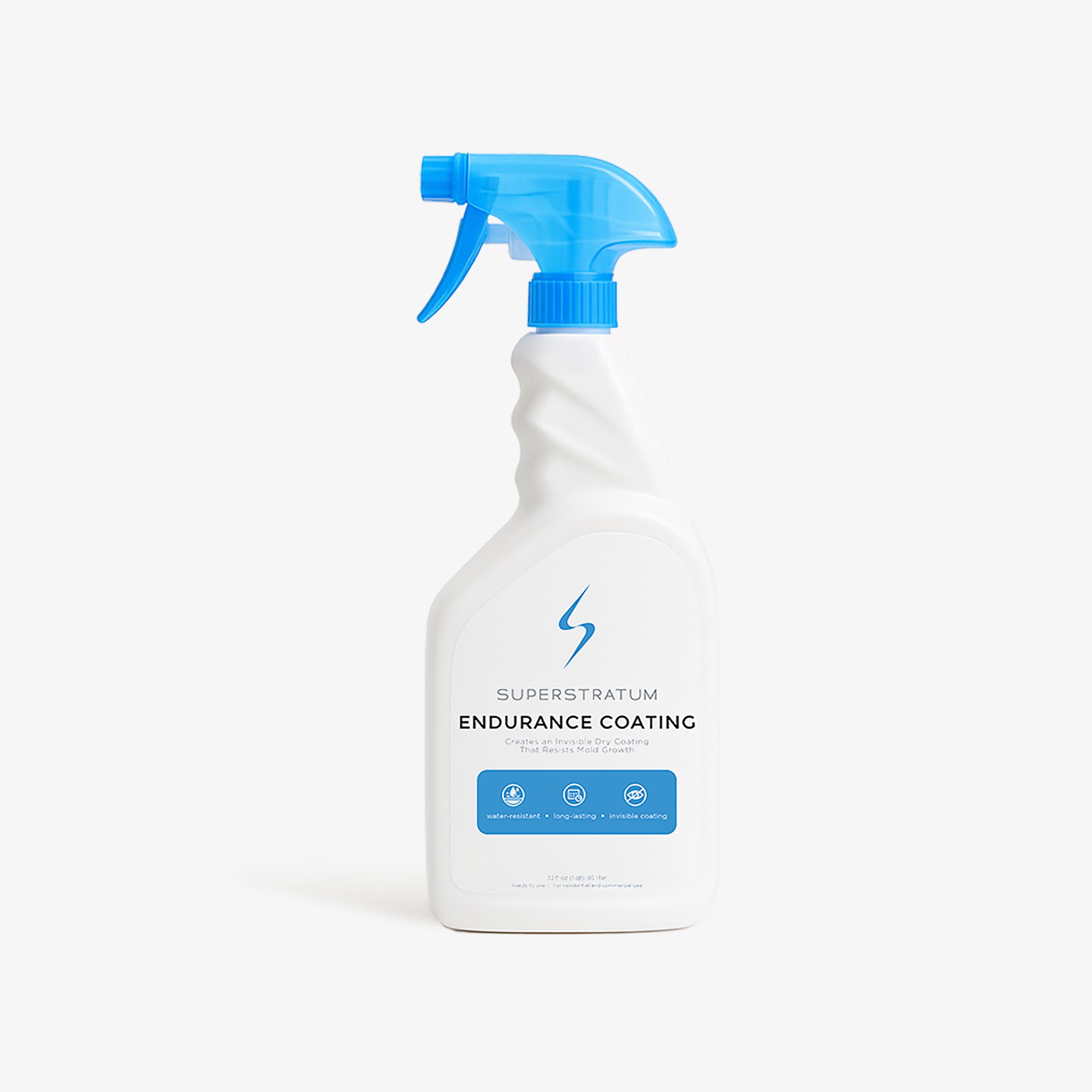There is still much to learn about the substances produced by mold, and even more about how to properly identify and remove them from indoor environments.
Growing awareness around indoor air quality has brought significant attention in recent years to the emerging problem of mycotoxins in our living environments. New evidence is showing these poisonous compounds are present at alarmingly high levels in a substantial number of U.S. homes—they are undetected by conventional mold testing—and can persist even after visible mold has been removed.
Addressing a sick home requires a solution that not only eliminates pathogens and microbes but more importantly denatures and destroys the molecular structure of a mycotoxin.
The Client's Mycotoxin Challenge
The client’s home was a 70-year-old property in a high-end neighborhood—clean, well-kept, and maintained. Despite the home’s good appearance, the couple’s daughter experienced chronic health issues they suspected were linked to the building.
The homeowners had already carried out their own DIY remediation work, and through their efforts, they believed they had successfully removed the visible mold. However, their daughter’s symptoms persisted. This realization led them to search for a specialized solution—and ultimately brought them to SuperStratum Labs.

Testing the Client's Home
The Mold and Mycotoxin Detection Kit is designed to be a simple, affordable way for homeowners to determine whether mold and harmful mycotoxins are present in their environment. The kit can be used in two ways:
1. Direct Source Testing – Apply the mold tape directly to visible mold growth and use the mycotoxin swab on the same sample. This method identifies the mold species and shows whether it is actively producing mycotoxins.
2. Environmental Dust Testing – Collect samples from dusty surfaces such as door frames, bookshelves, or other areas where dust settles. Using both the mold tape and the mycotoxin swab in this way can reveal whether mold and mycotoxin contamination exist anywhere in the home—even if no mold growth is visible.

Mold & Mycotoxin Detection Kit
The Procedure
To begin our job, the Superstratum team wanted to determine whether there were signs of mold in the home and whether mycotoxins were present. This distinction is critical, as mycotoxins can persist in the environment long after the mold that produced them is gone. By only testing for mold, mycotoxins can be missed and remain in the environment, escaxerbating the chornic health conditions of occupants.
Mold Spore Findings
If these results were judged on mold presence alone, many homeowners, mold remediators, and even environmentalists might not consider them alarming. Additionally, the spore test told only part of the story—and not the part the homeowner needed most. It failed to explain why the family was feeling unwell, and it did not reveal the hidden dangers present in the home.
The mycotoxin findings paint a very different picture. While spore counts may appear within an “acceptable” range, they do not measure the invisible, toxic compounds that mold can leave behind. In this case, the mold test underestimated the severity of the problem and missed what was actually making the family sick.

Ascospores
Spores from a large group of fungi, many of which grow on decaying organic matter. Some species are harmless, while others can be allergenic to sensitive individuals.
Aspergillus/Penicillium
Common indoor mold that thrives on damp building materials. Some species can produce harmful mycotoxins such as Ochratoxin A and Aflatoxin, and can also trigger allergies or respiratory issues.
Myxomycetes
Also known as slime molds; generally non-toxic and found in soil or decaying vegetation, but their spores can be allergenic to some people.
Mycotoxin Findings
The mycotoxin results confirmed the homeowner’s suspicion: even without alarming spore counts, dangerous mycotoxins were present at levels capable of causing adverse health effects, making a targeted mycotoxin removal plan essential.
By most traditional inspection standards, these mold counts would not raise significant concern. However, low spore counts can be misleading—as the mycotoxin swab results revealed, toxic chemical residues can remain even after mold is no longer actively growing.

Potential Health Risks for the Family

Sterigmatocystin (STC)
Produced by: Certain species of Aspergillus and Penicillium.
Health impacts: Associated with liver and kidney damage, immunosuppression, and increased cancer risk. It causes DNA damage and oxidative stress, leading to mutations and tumor development in animal studies [4][5].

Stachybotrylactam
Produced by: Stachybotrys chartarum (“black mold”).
Health impacts: Stachybotrys toxins are linked to respiratory inflammation, immune dysfunction, and neurological effects. Animal studies show systemic health effects, and historical human cases associate S. chartarum with pulmonary hemorrhage in infants (though not conclusively proven) [9][10].
Inhalation Pathway of Mycotoxins to the Bloodstream and Brain
Mycotoxins and ultrafine particles can also bypass the blood–brain barrier altogether by traveling directly from the nasal cavity into the brain through the olfactory and trigeminal nerves [1]. This dual pathway explains why exposure to mycotoxin-laden dust is associated not only with respiratory illness, but also with systemic, cognitive, and neurological effects. Click here.
Hayes Microbial Consulting x Supertratum Labs
A Partnership to Keep Families Safe
Mycotoxin testing for homes is a new and developing science. Unlike basic mold spore tests, which often miss the root cause of illness, mycotoxin testing measures the toxic byproducts mold can release into the environment. Accuracy and sensitivity vary across the few available methods, and until recently, this type of testing was limited to professional and industrial use.
At SuperStratum Labs, we partnered with Hayes Microbial Consulting to change that—developing the SuperStratum Mold & Mycotoxin Detection Kit to give homeowners direct access to clear, actionable results.
Through this partnership, we’ve made liquid chromatography–mass spectrometry (LC-MS) testing—a gold-standard method typically reserved for the pharmaceutical industry and other highly specialized fields—accessible to homeowners. LC-MS is renowned for its unmatched precision, but until now, it has remained out of reach due to the high cost of equipment and ongoing laboratory upkeep.
Hundreds of molds. Over 40 mycotoxins.
The SuperStratum Mold & Mycotoxin Detection Kit is the industry-leading solution for homeowners, delivering the highest level of accuracy and the broadest range of detection available today.
👉 To learn more about why we chose LC-MS over other available methods, explore the lab behind the test here.
Where do you begin when a home is sick?
For many families living in a sick home, the situation is not always straightforward. It’s rarely just a matter of whether mold is present. Families often ask: Are mycotoxins still lingering even after mold remediation? How do HVAC systems contribute to spreading contamination? And in what sequence should all of these issues be addressed? What if I can't afford that?
This is where our four-step structured framework becomes essential. The framework provides a way to understand how to use the Superstratum Whole-Home Detox in the broader context of a sick building—one that may involve water intrusion, visible mold growth, contaminated HVAC systems, and persistent health symptoms.
The Whole-Home Detox itself is the final step of this framework—the part that specifically targets chemical mycotoxins, VOCs, and fine particulates that remain after traditional remediation. But its effectiveness comes from being applied at the right time, after moisture, mold, and air handling issues have already been addressed to the best of the homeowner’s ability.
In the following section, we’ll show how our team applied this four-step framework in the Arlington case and why sequencing matters so much for achieving lasting results.
Address the Moisture
The basement and garage had a known history of water intrusion due to poor exterior drainage. The homeowner corrected the exterior drainage, stopping the ongoing moisture source feeding microbial growth.
Address the Mold
The homeowner performed a DIY mold treatment, removing visible contamination. While this addressed visible mold, it could not remove the microscopic residues and mycotoxins left behind.
Address the Air
To prevent spores and toxins from recirculating, the family hired an HVAC company to thoroughly clean the ductwork, eliminating any mold growth or contaminated dust.
Detox the Home
Even after visible mold removal and HVAC cleaning, harmful mycotoxins were present. We implemented the Superstratum Whole Home Detox to neutralize and physically remove them.

Plan of Attack: The Whole-Home Detox
We implemented the SuperStratum Whole-Home Detox, a process that pairs targeted HE-HOCl and CLO2 chemistry, scientifically proven to break apart mycotoxins at the molecular level, with a thorough small particle cleaning protocol. This three-phase approach first neutralizes the toxins so they are no longer dangerous, and then physically removes them from the home. By addressing both the chemical and physical side of contamination, we eliminated the hidden hazards that other remediation methods often leave behind.
Access our Whole Home Detox manual for the full details instructions.
Phase I – Cleaning
Fogging the Home
We began by fogging SuperStratum Building Cleaner into the environment. As the micro-fog settled, it knocked airborne dust and particulates out of circulation while breaking down mycotoxins clinging to surfaces and embedded in dust particles. This step actively neutralizes dangerous mycotoxins. Unlike mold fogging products that may kill mold spores but don’t break down mycotoxins, SuperStratum’s HE-HOCl is independently verified to break apart the molecular structure of mycotoxins, rendering them harmless before physical removal.
Superstratum Whole Home System - Step 1
Superstratum Whole Home System - Step 2
The Small Particle Clean
The Whole-Home Detox is not just a combination of cleaning products—it’s a mechanical process supported by chemistry that denatures mycotoxins. The most important phase is the mechanical wiping of inert dust after fogging, known as a small particle clean.
- Every surface in the home—walls, counters, trim, furniture—is wiped by hand using SuperStratum Building Cleaner and disposable wipes.
- Wipes are disposed of immediately to prevent recontamination.
- Belongings are wiped thoroughly, as mycotoxins often cling to surfaces like books, décor, electronics, and fabrics.
Phase II – Gas Phase
For this Arlington home, we deployed Superstratum Deodor Bombs in every room. These devices release a carefully measured dose of chlorine dioxide (ClO₂) gas, allowing it to penetrate deep into porous materials, hidden recesses, and micro-crevices that liquid sprays or fogs cannot reach.
This phase was essential for oxidizing and breaking down residual mycotoxins, VOCs, and odor molecules trapped in fabrics, wall cavities, and other hard-to-reach reservoirs. Before releasing the gas, we raised the home’s relative humidity to around 70% for optimal ClO₂ effectiveness. The home was vacated overnight for 12 hours, then aired out.
Superstratum Whole Home System - Step 5 - YouTube
Why We Don’t Use or Recommend Ozone
The U.S. Environmental Protection Agency (EPA) advises against the use of ozone generators for indoor air cleaning. The EPA also warns that ozone reacts with indoor materials to form secondary pollutants such as formaldehyde, adding further respiratory risks [11].
In addition, ozone generators can create nitrogen oxides (NO and NO₂) as by-products, which are themselves harmful respiratory irritants [12].
For these reasons, ozone is not recommended for mold or air cleaning.
Phase III - Coating
A 10-Year Mold-Resistant Coating
The final step was the application of SuperStratum Endurance Coating to high-moisture-risk surfaces throughout the home.
Unlike many mold-resistant coatings that rely on encapsulation, Endurance Coating is invisible, permeable, and breathable. It allows treated surfaces to maintain their natural vapor permeability while resisting mold growth. It bonds at a microscopic level, delivering long-lasting performance without trapping moisture or altering the look of the surface.
Every Job is Different
No two homes are alike, and no two detox jobs are exactly the same. Each property has its own layout, history, and environmental conditions that require adjustments to the process.
In this case, one key challenge was an unconditioned storage room directly adjacent to a conditioned basement. The temperature differential between the two spaces allowed moisture to condense on the shared wall inside the unconditioned storage room, creating ideal conditions for microbial growth and mycotoxin persistence.
We addressed this in two key ways:
Airflow & Humidity Control
We instructed the homeowner to keep the door open, leveraging the basement's HVAC system for dehumidification and temperature equalization in the storage room.
Mold-Resistant Coating
We applied Superstratum Endurance Coating to all storage room surfaces, providing long-term a long term and invisible mold resistance.
By combining building science adjustments with effective chemistry, we gave this space a much better chance of staying clean and safe.
Post-Results
When planning post-remediation verification, it’s important to understand how dust collection timing can affect results:
- If all dust is removed, post-testing only confirms no new contamination, not neutralization of existing toxins.
- To verify neutralization, we recommend leaving settled dust undisturbed for sampling, or waiting for natural dust re-collection before testing.
After completing the SuperStratum Whole-Home Detox, follow-up LC-MS testing showed all previously detected mycotoxins were below detectable limits.
In this Arlington home, we intentionally left dust in place on surfaces to ensure our testing could directly confirm that the original mycotoxin contamination had been denatured and rendered harmless. The LC-MS results following treatment validated this approach, showing a complete elimination of detectable Stachybotrylactam and Sterigmatocystin.

Conclusion
By combining sensitive LC-MS testing, HE-HOCl and CLO2 chemistry, mechanical small particle cleaning, and long-term mold-resistance, we transformed this home from a hidden health hazard into a safe, healthy environment—confirmed with scientific precision.
And most importantly, the SuperStratum Whole-Home Detox is designed to be both effective and simple enough for homeowners to perform themselves. Our goal is to put professional-grade detoxification tools directly in your hands.
If you’d like more information about our products or our professional service options, please contact us.
The Superstratum Whole Home Detox
Still feeling the effects of a sick home, even after remediation? The Whole Home Detox is our proven, patent-pending system to clear the lingering contaminants.
References
[1] Springer. Toxicology of Inhaled Substances. “The respiratory tract is a primary portal of entry for toxins, with alveoli providing direct transfer into circulation.” Springer
[2] MedicalXpress. “Inhaled toxic particles can cross the lung’s air–blood barrier, enter the bloodstream, and reach the brain.” MedicalXpress
[3] International Agency for Research on Cancer (IARC). Monographs on the Evaluation of Carcinogenic Risks to Humans. Group 2B: Sterigmatocystin classified as a probable human carcinogen. IARC Monograph
[4] HealthMatters. “Sterigmatocystin.” healthmatters.io
[5] Sherlock Inspector. “Sterigmatocystin.” sherlockinspector.com
[6] Viegas C, et al. (2018). “Sterigmatocystin in Indoor Environments.” Mycotoxin Research. tandfonline.com
[7] Bloom E, et al. (2017). “Detection of Stachybotrys Mycotoxins in Indoor Dust.” Analytical and Bioanalytical Chemistry. Springer Link
[8] PSE Community. “New Mycotoxins from Stachybotrys.” psecommunity.org
[9] Pestka J, et al. (2008). “Toxicology of Stachybotrys chartarum.” Toxicological Sciences. Oxford Academic
[10] Wikipedia. “Stachybotrys chartarum.” Wikipedia
[11] U.S. Environmental Protection Agency (EPA). Ozone Generators that are Sold as Air Cleaners. Available at: https://www.epa.gov/indoor-air-quality-iaq/ozone-generators-are-sold-air-cleaners
[12] California Air Resources Board (CARB). Ozone Generators Sold as Air Cleaners. Available at: https://ww2.arb.ca.gov/resources/fact-sheets/ozone-generators-sold-air-cleaners
[13] Indoor Air Quality Science, Lawrence Berkeley National Laboratory (LBNL). Ozone and Indoor Chemistry. Available at: https://iaqscience.lbl.gov/ozone
[14] U.S. Environmental Protection Agency (EPA). Technical Assistance Document for the Reporting of Daily Air Quality – the Air Quality Index (AQI). Notes on ozone reactions producing nitrogen oxides.









